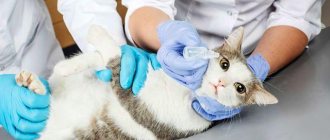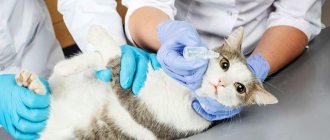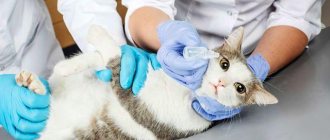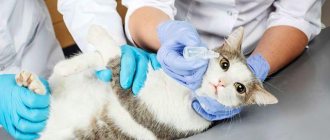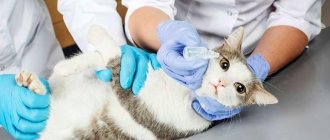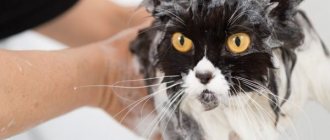Pregnancy of a pet is a joyful and important event. Cats become sexually mature by 6-8 months and, if the owner does not plan to sterilize her, you need to be prepared for childbirth. When a female gives birth for the first time, it is especially exciting.
Nature made sure that cats did everything on their own, but sometimes it needs to be stimulated. Street animals often find a secluded place and do not bother their owners. But helping a cat give birth in a city apartment is often necessary.
How to prepare? What to do when your cat doesn't push well? What drugs should I use? When to see a doctor? What to do if a cat gives birth for the first time? We will answer these and other questions further.
Stages of pregnancy
Short-haired and hairless breeds bear kittens for 55-65 days, long-haired breeds - up to 75 days. Pregnancy time also depends on the number of babies in the womb. The more kittens, the faster the birth will occur. However, if there are 1-2 cubs in the litter, then they can be expected with some delay.
ATTENTION! Sometimes one meeting with a male is not enough. Conception can occur a third or subsequent times, so it is difficult to determine the exact date of pregnancy at home.
Let's trace the stages of pregnancy for clarity:
- By the 20th day, the cat’s nipples become rounded, turn pink, and may peel. The female moves less and avoids high surfaces. He prefers sleep to active games and eats heavily several times a day. The belly increases slightly, but in long-haired breeds this is not noticeable. When palpating, you can feel the developing fetus, but this should be done carefully, because hasty actions will harm both the cat and the baby.
- From day 40, the fetus begins to actively develop. Gradually, limbs, head, and tail are formed. Internal organs are being formed and the nervous system is developing. Subsequently, the fetus acquires features inherent in cats, and also acquires sparse hair. The cat gradually loses its appetite.
- By week 6, the fruits descend into the abdominal cavity and stretch out. The belly is noticeably rounded, but if there are only one or two kittens, the changes are practically invisible. The abdominal cavity increases noticeably and takes the shape of a pear.
- After the 50th day, future kittens move actively. If there are many of them, then there is not enough space for everyone. The cat is experiencing discomfort. The expectant mother experiences vaginal discharge and colostrum appears from the nipples. The pelvis relaxes, and any day now the cat will give birth. She restlessly walks around the apartment or lies for a long time in a pre-prepared nest.
Maine Coon, British, Persian and Sphynx cats often require owner intervention and, in rare cases, veterinary intervention.
Why is constipation dangerous during breastfeeding?
Deterioration of intestinal function negatively affects a woman’s physical condition. Bloating and heaviness appear in the abdomen, and appetite decreases. Constipation may cause sleep disturbances, headaches, increased nervousness and decreased performance.
In addition, with constipation during lactation, fewer digestive enzymes enter breast milk, which also affects the baby’s stool. In some cases, delayed bowel movements can cause a reduction in breast milk production.
To normalize intestinal function, it is necessary to reconsider the daily diet and physical activity regime.
Preparation
Preliminary measures will not be superfluous, although most breeds cope well with pregnancy on their own. So what should you do if your cat gives birth for the first time?
First, we set up a nest. A regular cardboard box is perfect for this. We put a diaper or any other fabric on the bottom for convenience. Experienced owners recommend using several layers of soft paper or baby diapers. Special houses for cats are suitable for nesting. The main thing is that the expectant mother has free access.
Secondly, the cat should build a nest in a warm, ventilated room. We exclude drafts and the presence of other animals. We exclude the toilet and bathroom. The ideal option would be a small room where the cat will not be disturbed. For example, a storage room.
Thirdly, in order for the pet to successfully give birth, it is provided with food and clean drinking water. All this is placed near the nest or place where the cat prefers to sleep. Presumably she will give birth there.
What items will be needed to help the cat, stimulate and speed up the process? The list may change, but if the owner has most of the above, then half the battle is already done:
- Disposable diapers and wet wipes.
- Scissors.
- Disposable syringes and a number of medications to eliminate complications.
- Vaseline oil to stimulate the vaginal muscles.
- Surgical (or silk) thread to tie the umbilical cord.
- Iodine, brilliant green, disinfectants.
Causes of problems
Taking a dip at home is quite easy. It doesn’t matter if it’s a village house or a city apartment. But in some cases, the pregnancy period has passed, and the cat still does not give birth, although all the signs are obvious. The kittens will continue to grow, taking away strength and energy. The larger the fetus, the more difficult the birth will be. They should not be tightened.
Let's list the main reasons why a cat is unable to go into labor on time:
- malposition;
- the kitten is too big;
- narrow pelvis;
- insufficient amount of lubricant;
- incomplete dilatation of the cervix;
- age of the cat;
- mechanical injury;
- inflammation of the genital organs;
- the cat is overweight;
- breed characteristics - dwarf, Himalayan;
- anatomical properties of the vaginal vault.
Weak labor activity stands out. There are two main types. The first is a slight tone of the uterus. It is caused by a lack of the hormone oxytocin. In rare cases, calcium. The second occurs when labor lasts more than a day, the cat has lost a lot of strength and can no longer push.
To avoid the problems described above, a pregnant cat is taken to a veterinarian before giving birth. He conducts examinations and makes recommendations if any of the listed anomalies are detected. In rare cases, hospital observation is required to prevent the death of a cat and its offspring. This could be a clinic in Moscow or a good provincial one.
What to do if there are complications during childbirth in a cat?
If you notice any deviations from the normal course of labor, the cat should be taken to a veterinary clinic as soon as possible. Due to the temperamental characteristics of cats, almost all cases of dystocia (impaired labor) associated with mechanical causes end in caesarean section. The fetus, located in the birth canal and unable to come out, experiences acute oxygen starvation, so a cesarean section in such a case must be performed as quickly as possible.
How to induce labor at home
It should be understood that there are a large number of drugs on the market. In any case, it is better to consult a veterinarian who will take into account the individual characteristics of the cat. A number of drugs are excellent at inducing and accelerating the birth of your pet.
Let's look at the main medications that are used for stimulation:
- Oxytocin. Perhaps the main drug used in difficult childbirth. However, incorrect dosage can lead to bleeding and cervical rupture. Before use, consultation with a veterinarian is required!
- Traumatin. Used as an analgesic and prophylactic for difficult childbirth. Travmatin is effective in healing wounds with damage to the genital organs. Prevents infection of the uterine cavity by pathogenic microbes.
- Gamavit. Directly stimulates the muscles of the uterus. Often used in prolonged labor and difficult cases.
- Calcium gluconate. A lack of this element often leads to complications along with oxytocin. The drug enhances labor activity as it acts. It also provokes the formation of milk. Used to relieve nervous tension after childbirth.
Lack of calcium leads to the development of eclampsia - acute postpartum depression, which negatively affects the nervous system and causes severe convulsions. In advanced cases it leads to the death of the animal.
Veterinary practice knows cases when labor can be induced without the use of medications. Let us note two main methods.
Option one
The owner puts on gloves. Puts the cat in a position where she goes to the toilet "in large quantities." Next, massage the abdomen in a circular motion. After a couple of minutes, dip your finger in Vaseline oil and insert it into the cat’s vagina about a centimeter. Circular movements are repeated again. Mechanical actions help stimulate and speed up labor.
Option two
When oxytocin is contraindicated for a cat for some reason or the owner does not risk using it, then the following method will come to the rescue. Using a disposable syringe, mix 2 ml of ascorbic acid, 4 ml of glucose, 4 ml of calcium gluconate. We administer intramuscularly or intravenously, but only after the female has given birth to her first baby.
For every 5 kg of weight, 1 ml of the resulting solution is sufficient. It is also used after childbirth as a prophylaxis against eclampsia.
Physical exercise
One of the effective and affordable methods for preventing constipation in a nursing mother is light physical activity. Regular exercise will help strengthen the abdominal and perineal muscles. As a result, muscle tone increases, which helps to activate intestinal motility. Yoga, walking, swimming, and Pilates are suitable exercises for nursing mothers.
Also, don't ignore your daily warm-up. It is best to do exercises on an empty stomach. You should start with simple exercises, gradually increasing complexity. There are also specific exercises that increase intestinal contractility and help cope with constipation, for example:
- Stand straight with your feet shoulder-width apart.
- Take a deep breath, then strongly draw in and then sharply push out your stomach.
- Repeat the action 10 times and take a break.
Exercises must be performed at a slow pace, without sudden jerks. The main thing is regularity. As you get stronger, you can increase the number of repetitions. Gymnastics will help normalize bowel movements and improve your well-being.
Exercises while lying on your back
- Take a breath, stick out your stomach. As you exhale, draw in your stomach and lightly press your hands on the abdominal wall.
- Place your hands behind your head and stretch. At the same time, pull in your stomach. As you exhale, lower your arms and place them along your body.
- Lying on your back, bend your knees without lifting your heels off the floor.
- Pull your right knee towards your stomach as you exhale. Lower your leg while inhaling. Repeat the same with your left leg.
The “bicycle” and “scissors” exercises are good for constipation.
Exercises while lying on your stomach
- Place your hands under your shoulders. Get on all fours, without taking your hands off the floor, and then roll onto your feet. Take the starting position.
- Perform alternating leg swings with simultaneous retraction of the abdomen as you exhale and retraction as you inhale.
Stages of the procedure
Specialists note several stages that precede the birth of kittens. The cat walks restlessly, the babies are actively moving in the stomach.
The first stage of labor begins. It lasts up to 24 hours. The cat's body temperature drops by 2-3 degrees. This is a natural process. The cat actively licks the nipples or genitals. In some cases, vomiting is observed. It is better to transfer the expectant mother to a previously prepared nest. There she will feel safe and prepared for childbirth.
The cat's water breaks and her pulse quickens. Breathing is occasionally interrupted. The contractions began. The pet meows loudly, sometimes turning into a scream. The owner calms the cat down by talking and lightly stroking the belly.
The second stage begins. The abdominal and diaphragm muscles are activated. The cat is pushing hard and the baby is gradually moving forward. The amniotic sac partially ruptures and fluid flows from the vagina.
Many owners are interested: is a kitten born feet first or head first? In this, cats copy humans. Like a human baby, a kitten is born head first. But it is worth noting that birth with the pelvis or paws forward should not cause concern to the owner. This is natural for cats.
The mother licks the baby, freeing it from the amniotic sac. Cats often eat this afterbirth. It is rich in vitamins and minerals. But a large amount of afterbirth eaten causes indigestion. The optimal quantity for a female is 2 pieces. In most cases, the cat chews the umbilical cord on its own.
ATTENTION! The number of afterbirths exactly corresponds to the number of kittens. Sometimes their number does not match. This means that one of the placentas remained inside the uterus. It must be removed to prevent inflammation of the genital organs in the future.
The final, third stage comes into force. The animal's uterus comes to rest until the next kitten appears. The break between births lasts from 10 to 60 minutes. The cat can drink and rest a bit.
The time of birth is an individual value. But if they continue for more than 24 hours, you should contact your veterinarian.
Treatment of constipation in nursing mothers
Not all pharmaceutical products are suitable for nursing mothers. To choose medications, it is best to consult a doctor. The specialist may prescribe microenemas, rectal suppositories or oral medications.
But most medications can only be used for a short time. Other methods will help normalize stool during breastfeeding.
The doctor's first recommendation for treating constipation during breastfeeding is a balanced diet. Laxatives are prescribed when measures to correct the diet are ineffective or there is a high risk of complications, in cases where constipation requires emergency help.
There is one most important principle of treatment: the development of a morning reflex to bowel movement. It is important to try to maintain a daily routine, setting aside enough time to go to the toilet in the morning immediately after waking up and having breakfast. This can be difficult for a new mother, especially on days when the baby is restless. But you should pay attention to your needs even in this case.
Compliance with the drinking regime is of great importance. During lactation, large amounts of fluid are required, so it is important to drink at least 1.5-2 liters of water per day.
Physical activity improves microcirculation, stimulates intestinal motility, strengthens the muscles of the peritoneum and pelvic floor. You should consult a doctor so that he can suggest light exercises based on your health condition.
Herbal medicine should be selected with care by a nursing mother. There are a number of medicinal herbs approved for use. Herbal decoctions and infusions should be taken according to the recommendations of a specialist.
Laxatives should be prescribed by a doctor. There are not many products allowed for nursing mothers. It is important to avoid taking stimulant laxatives, which are addictive. It is allowed to take bulk laxatives, osmotic agents, and topical medications. There are categories of laxatives that are approved for long-term use and have a beneficial effect on the digestive system of a young mother.
What kind of help will you need?
So, we figured out how to induce and stimulate labor. But in some cases complications may occur. You will need the owner's help. Let's look at the most common cases and specific actions. It is especially useful for people to know when a cat gives birth for the first time:
The fetus is large and does not pass through the uterus
We have found that it is preferable for a kitten to be born head first. There is nothing wrong with walking feet first, but it often causes complications for the cat. What to do if the fruit is large?
We put on gloves, having previously lubricated our fingers with Vaseline oil. We insert a finger into the vagina and feel the folds of the kitten’s paws. We move the baby from side to side, trying to stretch the limbs forward. We grab the paws in the area of the shoulder joint.
Sometimes the baby is far from the exit of the uterus. We provoke contractions in the cat by stretching the vagina.
The cat did not chew the umbilical cord
It is worth waiting 10-15 minutes; if the woman in labor does not take any action, then you need to help her. We squeeze the umbilical cord with two or three fingers at a distance of 3-4 centimeters from the kitten’s belly. We tie it with silk or surgical thread. We take sterile scissors in our hands. Surgical ones are better. We cut the umbilical cord. We treat the cut site with an antiseptic.
The kitten is not released from the amniotic sac
We wait one or two minutes and cut it ourselves. We take out the kitten and wrap it in cloth. We hold our head and bend our body so that our knees reach our chests. We perform the manipulations several times. Breathing should resume. If it does not appear, then perform artificial respiration. If necessary, remove amniotic fluid from the nose and ears with a pipette.
Kittens are still born
It’s a scary situation, but we don’t lose our composure. Sometimes severe contractions, low temperature or an abundance of mucus in the nasal cavity lead to the fact that the kitten only appears dead. We dry the baby. We clear the airways, turn the head down and gently shake. Next we put it on the mother’s chest.
The cat definitely gives birth to dead pets one after another. We palpate the female's belly. If one or two fetuses are felt, then immediately contact the veterinarian. A caesarean section may be required.
Can't give birth
If the female pushes weakly, then we use oxytocin, calcium gluconate or a solution of ascorbic acid and glucose. If the drugs do not help, then immediately contact the veterinarian. Resuscitation may be required.
The cat may bleed. If it continues for a long time, you should contact your veterinarian. The same applies to unpleasant vaginal discharge. There should be no sudden drop or rise in temperature.
If contractions last more than two hours, but labor has not begun, contact the clinic. This could be Moscow or any other city. It happens that two fruits try to pass at once.
Especially during the first birth, it is better not to take risks and seek help from specialists. Any complication will negatively affect the pet’s health. To the point of being unable to give birth again.
We use medications only after consultation with a veterinarian. It is good if another family member or friend provides assistance during childbirth.
Laxatives
A laxative during breastfeeding is necessary to provide immediate assistance to yourself. However, some remedies help normalize intestinal function in general. To understand the mechanism of their work, consider all groups of laxatives:
- stimulating;
- volumetric;
- osmotic;
- softening.
The first act on intestinal receptors. They are addictive and can cause complications such as lazy bowel syndrome. In addition, taking stimulant laxatives is not allowed during lactation, so the doctor will not recommend using drugs from this group.
Osmotic drugs do not pass into breast milk and are not addictive. They are often prescribed to nursing mothers. However, a significant part of such drugs are used in coloproctology and gastroenterology as a measure of preparation for endoscopic diagnostic methods, surgical interventions, etc. They reliably cleanse the intestines, but have a pronounced effect - they can cause frequent loose stools.
Softening agents are oils, glycerin, etc. They help soften stool and simplify their movement through the intestines. However, such drugs are not approved for continuous use, since they impair the absorption of fat-soluble vitamins. This can be fraught with the development of hypovitaminosis for a young mother.
Bulk laxatives are represented by herbal or synthetic-based drugs. They act similarly to natural fiber - they are not digested in the intestines, absorb water and swell, increasing the volume of intestinal contents and softening the stool. In addition, such drugs gently stimulate intestinal motility, causing defecation. The components of such products do not pass into breast milk. They are allowed for nursing mothers and can be taken for a long time.
One such remedy is the British drug Fitomucil Norm. It contains psyllium seed hull and plum fruit extract - natural soluble and insoluble fiber. The drug gently stimulates bowel movements and promotes regular bowel function.


